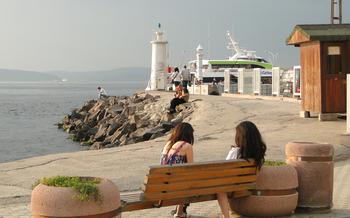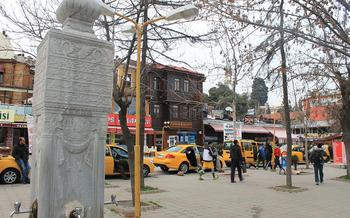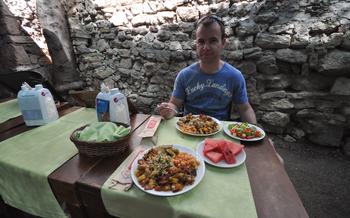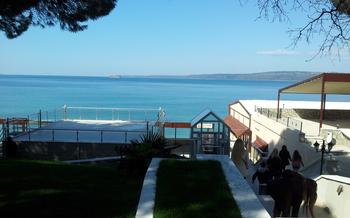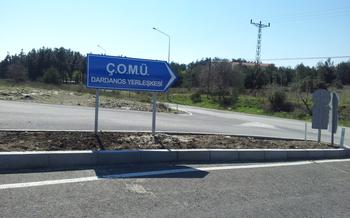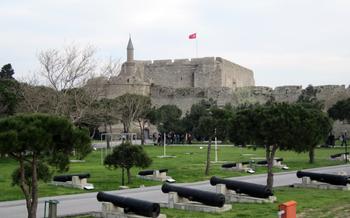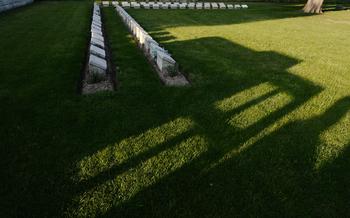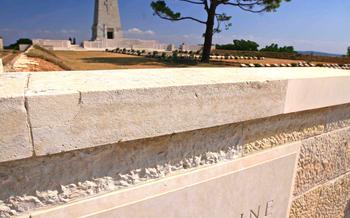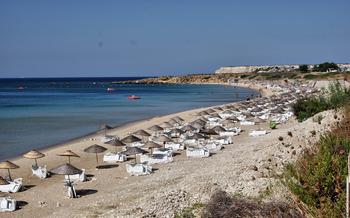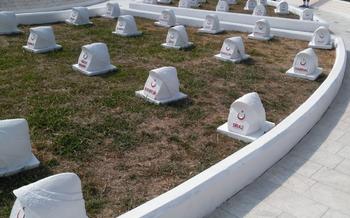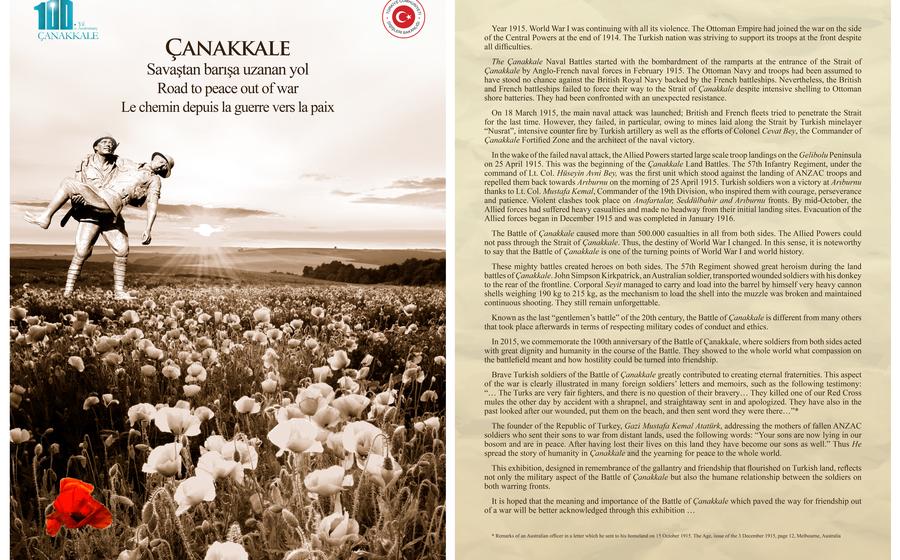
Çanakkale War Galleries
- Maritime Museum: A Glimpse into Naval Heritage
- Battlefield Tours: Retracing the Steps of History
- Çanakkale Martyrs' Memorial: Paying Tribute to the Fallen
- Çimenlik Castle: A Fortress with a Rich Past
- Morto Bay: A Place of Tranquility and Remembrance
- Lone Pine Cemetery: A Symbol of Sacrifice
- Chunuk Bair: A Battlefield of Epic Proportions
- ANZAC Cove: A Place of Remembrance for Allied Forces
- Historical Artifacts: Uncovering the Past
- Witness Accounts and Personal Narratives: Voices from the Front
- Educational Programs and Workshops: Learning from History
- Visitor Centers and Interpretive Signage: Navigating the Sites
- Respect and Remembrance: Honoring the Fallen
- Insider Tip: Planning Your Visit
Maritime Museum: A Glimpse into Naval Heritage
Situated alongside the Çanakkale War Galleries, the Maritime Museum offers a captivating journey through the rich naval history of Turkey. Its extensive collection of exhibits showcases the evolution of the Turkish Navy, from its humble beginnings to its present-day status as a formidable maritime force.
Among the highlights of the museum are artifacts and relics from significant naval battles, including the legendary Çanakkale War. Visitors can marvel at the intricate models of warships, examine authentic uniforms and weaponry, and learn about the strategies and tactics employed by the Turkish Navy throughout the ages.
Interactive displays and educational resources further enhance the museum experience, providing visitors with a deeper understanding of the challenges and triumphs faced by Turkish sailors. Whether you're a history buff, a naval enthusiast, or simply curious about Turkey's maritime heritage, the Maritime Museum is a must-visit destination in Çanakkale.
Battlefield Tours: Retracing the Steps of History
Journey back in time and retrace the footsteps of soldiers on guided battlefield tours of the Çanakkale War. Immerse yourself in the strategies and tactics employed by both sides as you explore the battlefields where history unfolded. Hear personal stories and anecdotes from soldiers and eyewitnesses that bring the conflict to life. These tours offer a unique perspective on the war, allowing you to understand the motivations, sacrifices, and challenges faced by those who fought. Whether you're a history buff or simply seeking a deeper connection to the past, these battlefield tours provide an unforgettable and educational experience.
Çanakkale Martyrs' Memorial: Paying Tribute to the Fallen
The Çanakkale Martyrs' Memorial stands as a poignant testament to the immense sacrifice and bravery of the soldiers who fought in the Çanakkale War. Erected in 1960, this awe-inspiring memorial immortalizes the memory of the fallen heroes who laid down their lives for their homeland.
The memorial's striking architecture, designed by renowned Turkish architect Emin Onat, is a sight to behold. Its towering obelisk, reaching towards the heavens, symbolizes the eternal spirit of the martyrs. At the base of the obelisk, a poignant sculpture depicts a grieving mother embracing her fallen son, capturing the depth of loss and sorrow experienced by those who lost loved ones in the war.
Commemorative ceremonies and events are held annually at the memorial, attended by government officials, military personnel, and descendants of the fallen soldiers. These solemn gatherings serve to honor the sacrifices made by the martyrs and perpetuate their memory for generations to come.
Perhaps the most evocative feature of the memorial is the eternal flame that burns incessantly at its center. This flickering flame represents the unwavering spirit of the martyrs, whose legacy continues to inspire and unite the Turkish people.
Çimenlik Castle: A Fortress with a Rich Past
Çimenlik Castle, a formidable fortress overlooking the Dardanelles Strait, played a crucial role in the Çanakkale War. Built in the 15th century by the Ottoman Empire, the castle served as a strategic defensive point, guarding the narrow waters against invading forces. During the war, it witnessed intense battles and served as a refuge for Turkish soldiers.
The castle's architectural features reflect its military significance. Its thick stone walls, towers, and ramparts provided a strong defense against enemy attacks. Visitors can explore the castle's interior, which includes courtyards, barracks, and storage chambers, offering a glimpse into the lives of the soldiers who once occupied it.
From the castle's ramparts, visitors are rewarded with breathtaking panoramic views of the Dardanelles Strait and the surrounding landscape. The strategic location of the castle becomes evident, as it commands a sweeping vista of the waterway, allowing its defenders to monitor and control maritime traffic.
Çimenlik Castle stands as a testament to the resilience and determination of the Turkish people during the Çanakkale War. Its rich history and architectural features make it a must-visit destination for anyone interested in exploring the region's military and cultural heritage.
Morto Bay: A Place of Tranquility and Remembrance
Morto Bay, situated on the Gallipoli Peninsula, holds a poignant significance in the narrative of the Çanakkale War. During the fierce battles, the bay served as a strategic location for the Allied forces, particularly the British, as they sought to establish a foothold on the peninsula. However, the bay also became a solemn resting place for many soldiers who lost their lives in the conflict.
Today, Morto Bay exudes an atmosphere of tranquility, inviting visitors to reflect on the sacrifices made during the war. The serene surroundings, with gentle waves lapping against the shore, stand in stark contrast to the tumultuous events that unfolded here over a century ago.
Memorials dedicated to fallen soldiers from both sides of the conflict adorn the bay, paying tribute to their bravery and sacrifice. The names of those who perished are etched in stone, serving as a poignant reminder of the human cost of war.
Visitors to Morto Bay can take a moment of contemplation, honoring the memory of those who fought and fell in this historic battleground. The bay's tranquil ambiance provides a space for remembrance and reflection, allowing visitors to connect with the past and gain a deeper understanding of the sacrifices made during the Çanakkale War.
Lone Pine Cemetery: A Symbol of Sacrifice
Lone Pine Cemetery stands as a poignant symbol of the immense sacrifice and loss endured during the Çanakkale War. Established in 1915, this hallowed ground is the resting place for over 2,000 Australian and Turkish soldiers who fought valiantly in the fierce battle for Lone Pine Ridge.
The serene atmosphere of the cemetery invites visitors to reflect on the lives and sacrifices of these young men who fought far from their homelands. The meticulously maintained rows of white headstones, each bearing the name, rank, and unit of the fallen soldier, create a powerful visual reminder of the human cost of war.
Among the graves, one stands out—that of John Simpson Kirkpatrick, known as the "Man with the Donkey." This legendary figure, an Australian stretcher bearer, risked his life time and again to rescue wounded soldiers from the front lines, often under heavy fire. His selfless acts of bravery earned him the respect and admiration of both sides, and his story continues to inspire visitors to this day.
Lone Pine Cemetery serves as a poignant reminder of the futility of war and the profound impact it has on individuals and nations. It is a place where visitors can pay their respects to the fallen, learn about the history of the Çanakkale War, and reflect on the enduring legacy of sacrifice and courage.
Chunuk Bair: A Battlefield of Epic Proportions
The Battle of Chunuk Bair, fought as part of the wider Gallipoli campaign, stands as a testament to the ferocity and scale of the Çanakkale War. This strategic hilltop, fiercely contested by Allied and Ottoman forces, witnessed some of the war's most intense fighting and tragic loss of life.
Chunuk Bair's pivotal position overlooked the Dardanelles Strait, making it a crucial objective for both sides. The Allied forces, comprising mainly Australian and New Zealand troops, launched a daring assault on the hill in August 19After a grueling battle, they managed to capture and hold the summit for several days, amidst fierce Ottoman counterattacks.
However, the Ottomans, determined to regain control of the strategic position, launched a relentless counteroffensive. The fighting was relentless, with both sides suffering heavy casualties. Ultimately, the Ottomans succeeded in retaking Chunuk Bair, but the battle had exacted a heavy toll on both armies.
Today, Chunuk Bair stands as a poignant reminder of the sacrifices made by soldiers from both sides. The battlefield is dotted with commemorative monuments and memorials, honoring the fallen and paying tribute to their bravery. Visitors can explore the site, following in the footsteps of those who fought and died here, gaining a deeper understanding of the significance and human cost of this epic battle.
ANZAC Cove: A Place of Remembrance for Allied Forces
ANZAC Cove holds a significant place in the history of the Çanakkale War as the landing site for Allied troops, primarily from Australia and New Zealand. The cove's tranquil atmosphere and scenic views provide a poignant backdrop for memorials and commemorative services honoring the ANZAC soldiers who fought and lost their lives during the campaign.
Visitors to ANZAC Cove can pay their respects at the Lone Pine Cemetery, where the graves of Australian and Turkish soldiers stand side by side, symbolizing the shared sacrifices of both nations. The cove also features memorials dedicated to the ANZAC troops, including the ANZAC Commemorative Site, which hosts commemorative services on significant anniversaries.
The tranquil ambiance of ANZAC Cove invites visitors to reflect on the courage and sacrifice of the ANZAC soldiers. The serene surroundings, coupled with the memorials and commemorative events, create a powerful sense of remembrance and honor for those who fought and fell in this historic battle.
Historical Artifacts: Uncovering the Past
Çanakkale's war galleries and museums house a wealth of historical artifacts that provide tangible connections to the Çanakkale War. These relics, ranging from weapons and uniforms to personal belongings, offer a poignant glimpse into the lives and experiences of the soldiers who fought on both sides.
A highlight of the collection is the display of weapons used during the war. Visitors can examine rifles, machine guns, and artillery pieces, gaining an understanding of the technological advancements that shaped the conflict. Uniforms from different regiments and ranks are also on display, showcasing the diverse backgrounds of those who served.
Beyond the military hardware, personal items such as letters, diaries, and photographs offer a deeply personal perspective on the war. These artifacts reveal the hopes, fears, and aspirations of the soldiers, providing a human dimension to the historical narrative.
The stories behind these artifacts are equally captivating. A poignant example is the diary of a young Turkish soldier, which recounts his experiences on the front lines and his eventual capture by Allied forces. His words vividly convey the hardships and horrors of war, as well as his determination to survive.
Through these artifacts and their accompanying stories, visitors to Çanakkale gain a deeper understanding of the human toll of the Çanakkale War. These relics serve as powerful reminders of the sacrifices made by those who fought and died in this pivotal conflict.
Witness Accounts and Personal Narratives: Voices from the Front
Beyond the exhibits and historical accounts, the Çanakkale War Galleries offer a poignant glimpse into the personal experiences of those who lived through the conflict. Collections of letters, diaries, and firsthand accounts from soldiers and civilians provide a deeply moving and human perspective on the war. These narratives shed light on the hardships, sacrifices, and emotions of those caught in the midst of the fighting.
Through these personal accounts, visitors can gain a deeper understanding of the human toll and the individual stories behind the statistics. The letters reveal the hopes, fears, and camaraderie among soldiers, while the diaries offer a glimpse into their daily lives and struggles. The firsthand accounts from civilians provide a unique perspective on the impact of the war on ordinary people, whose lives were forever changed by the conflict.
By preserving and sharing these voices from the front, the Çanakkale War Galleries offer a powerful reminder of the human cost of war and the importance of remembering the sacrifices made by those who fought and lived through this defining moment in history.
Educational Programs and Workshops: Learning from History
The Çanakkale War Galleries offer a range of educational programs and workshops designed to engage students and visitors of all ages in the history and legacy of the war. These programs provide an interactive and immersive learning experience, fostering a deeper understanding of the conflict and its impact.
Interactive workshops and activities form a crucial part of these educational initiatives. Through hands-on experiences, participants explore various aspects of the war, such as the strategies and tactics employed, the daily lives of soldiers, and the impact of the conflict on the region. These workshops encourage critical thinking, collaboration, and a deeper appreciation for the complexities of the war.
Educational programs are tailored to different age groups and academic levels, ensuring an engaging and informative experience for all participants. Primary and secondary school students can embark on guided tours led by experienced educators, who bring the history of the war to life through storytelling and interactive activities.
Higher education institutions and adult learners can participate in specialized workshops and seminars that delve into the historical, social, and political dimensions of the Çanakkale War. These programs offer a platform for in-depth discussions, research, and analysis, fostering a comprehensive understanding of the conflict and its lasting legacy.
By incorporating educational programs and workshops into their visit, visitors to the Çanakkale War Galleries gain a profound appreciation for the complexities of the war, its human toll, and its enduring significance. These programs promote a deeper understanding of history, encourage critical thinking, and foster a sense of respect and remembrance for those who fought and lost their lives in the conflict.
Visitor Centers and Interpretive Signage: Navigating the Sites
Navigating the Çanakkale War Galleries and historical sites is made easier with the presence of visitor centers and interpretive signage. These resources provide essential information, maps, and guided tours, enhancing the visitor experience and facilitating a deeper understanding of the sites.
Visitor centers serve as a starting point for exploring the war galleries and battlefields. Here, visitors can gather information about the sites, including their history, significance, and highlights. Maps and brochures are available to help plan a route and identify must-see attractions. Guided tours led by knowledgeable experts are often offered, providing in-depth insights and anecdotes about the events that took place.
Interpretive signage is strategically placed throughout the war galleries and historical sites, offering context and explanations for what visitors are seeing. These signs provide historical background, describe key events, and highlight notable features of the sites. By reading the interpretive signage, visitors gain a deeper understanding of the significance of each location and the events that unfolded there.
With the help of visitor centers and interpretive signage, visitors can navigate the Çanakkale War Galleries and historical sites with ease, ensuring that they make the most of their visit and gain a comprehensive understanding of the events that shaped this pivotal conflict.
Respect and Remembrance: Honoring the Fallen
The Çanakkale War Galleries and the surrounding historical sites are not just tourist attractions; they are places of remembrance and reflection. The sacrifices made by the soldiers from both sides during the war should never be forgotten. Visitors are encouraged to show respect and pay tribute to the fallen by observing the commemorative ceremonies and events held at the sites. These ceremonies often include wreath-laying, speeches, and prayers, providing a solemn and moving opportunity to honor the memory of those who lost their lives.
Preserving the legacy of the Çanakkale War is essential for ensuring that the sacrifices made by the soldiers are not forgotten. This can be done through storytelling, education, and the preservation of historical artifacts and sites. By sharing stories and experiences, we can keep the memory of the war alive and pass it on to future generations. Education plays a crucial role in this regard, as it helps people understand the causes, consequences, and significance of the war.
Respecting and remembering the fallen soldiers of the Çanakkale War is not only a matter of historical accuracy but also a moral obligation. It is important to acknowledge the immense suffering and loss that occurred during the conflict and to honor the bravery and sacrifice of those who fought. By doing so, we can ensure that their memory lives on and that the lessons of the war are never forgotten.
Insider Tip: Planning Your Visit
To fully appreciate the significance of the Çanakkale War Galleries and the surrounding historical sites, it's essential to plan your visit strategically. The best time to visit Çanakkale is during the shoulder seasons, spring (April-May) and autumn (September-October), when the weather is pleasant, and the crowds are smaller.
Transportation to Çanakkale is convenient, with regular bus services from major cities like Istanbul and Ankara. Once in Çanakkale, getting around is easy, with local buses and taxis readily available. For a more immersive experience, consider staying in one of the charming guesthouses or boutique hotels in the city center, allowing you to soak in the local atmosphere.
When it comes to dining, Çanakkale offers a range of culinary delights. From traditional Turkish cuisine to international fare, there are options to suit every palate. Be sure to sample the local seafood, which is renowned for its freshness and flavor.
To make the most of your visit, allocate at least two days to explore the war galleries and the various historical sites. Start your journey with a visit to the Çanakkale War Galleries to gain a comprehensive understanding of the conflict. Then, embark on a battlefield tour to retrace the steps of history and gain insights into the strategies and tactics employed during the war.
Don't miss the Çanakkale Martyrs' Memorial, a poignant tribute to the fallen soldiers, and Çimenlik Castle, a testament to the region's rich history. For a moment of tranquility and remembrance, visit Morto Bay, where memorials honor soldiers from both sides who lost their lives in the conflict.
Lone Pine Cemetery and Chunuk Bair are must-see sites, offering a glimpse into the sacrifices made by soldiers from Australia, New Zealand, and Turkey. ANZAC Cove holds particular significance for those interested in the Allied forces' involvement in the war, with memorials and commemorative services honoring their bravery.
Throughout your visit, take advantage of the visitor centers and interpretive signage to enhance your understanding of the sites. Respectful behavior is expected, as these places serve as a reminder of the immense loss and sacrifice that took place during the Çanakkale War.
By following these tips, you'll be well-prepared to embark on a journey through history and pay tribute to the fallen heroes of the Çanakkale War.
